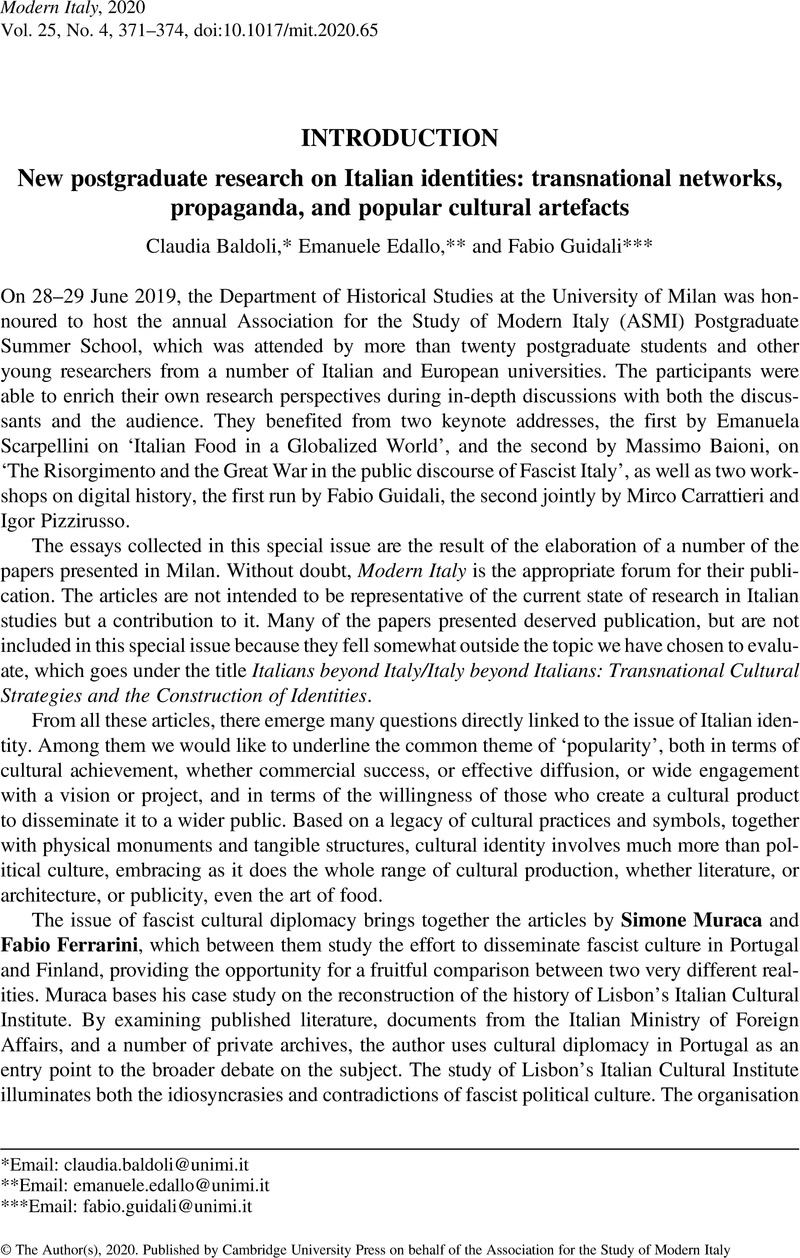No CrossRef data available.
Article contents
New postgraduate research on Italian identities: transnational networks, propaganda, and popular cultural artefacts
Published online by Cambridge University Press: 02 December 2020
Abstract
An abstract is not available for this content so a preview has been provided. Please use the Get access link above for information on how to access this content.

- Type
- Special Issue
- Information
- Modern Italy , Volume 25 , Special Issue 4: Italians Beyond Italy/Italy Beyond Italians: Transnational Cultural Strategies and the Construction of Identities , November 2020 , pp. 371 - 374
- Copyright
- Copyright © The Author(s), 2020. Published by Cambridge University Press on behalf of the Association for the Study of Modern Italy
References
Ben-Ghiat, R. 2004. Fascist Modernities: Italy, 1922– 1945. Los Angeles: University of California Press.Google Scholar
Cavazza, S. and Scarpellini, E., eds. 2018. Storia d'Italia. Annali 27. I consumi. Turin: Einaudi.Google Scholar
De Grazia, V. 1981. The Culture of Consent: Mass Organization of Leisure in Fascist Italy. Cambridge: Cambridge University Press.10.1017/CBO9780511528972CrossRefGoogle Scholar
Deplano, V. 2015. L'Africa in casa: propaganda e cultura coloniale nell'Italia fascista. Florence: Le Monnier.Google Scholar
Gabaccia, D.R. 1998. We Are What We Eat: Ethnic Food and the Making of Americans. Cambridge, MA: Harvard University Press.Google Scholar
Giuliani Caponetto, R. 2015. Fascist Hybridities: Representations of Racial Mixing and Diaspora Cultures Under Mussolini. New York: Palgrave McMillan.10.1057/9781137481863CrossRefGoogle Scholar
Giuliani, G. 2019. Race, Nation and Gender in Modern Italy: Intersectional Representations in Visual Culture. New York: Palgrave McMillan.10.1057/978-1-137-50917-8CrossRefGoogle Scholar
Giuliani, G., Lombardi-Diop, C.. 2013. Bianco e nero. Storia dell'identità razziale degli italiani. Florence: Le Monnier.Google Scholar
Kallis, A. 2014. The Third Rome, 1922–43: The Making of the Fascist Capital. London: Palgrave MacMillan.10.1057/9781137314031CrossRefGoogle Scholar
Labanca, N., ed. 1992. L'Africa in vetrina. Storie di musei e di esposizioni coloniali in Italia. Treviso: Pagus.Google Scholar
Marcello, F. 2018. ‘Building the Image of Power: Images of Romanità in the Civic Architecture of Fascist Italy’. In Brill's Companion to the Classics, Fascist Italy and Nazi Germany, edited by Roche, H. and Demetriou, K., pp. 325–369. Leiden: Brill.Google Scholar
Maulsby, L. 2014. Fascism, Architecture, and the Claiming of Modern Milan, 1922–43. Toronto: University of Toronto Press.10.3138/9781442665255CrossRefGoogle Scholar
Trentmann, F. 2016. Empire of Things: How We Became a World of Consumers, from the Fifteenth Century to the Twenty-First. London: Allen Lane.Google Scholar
Waldinger, R. 2015. The Cross-Border Connection: Immigrants, Emigrants, and Their Homelands. Cambridge, MA: Harvard University Press.10.4159/harvard.9780674736283CrossRefGoogle Scholar




